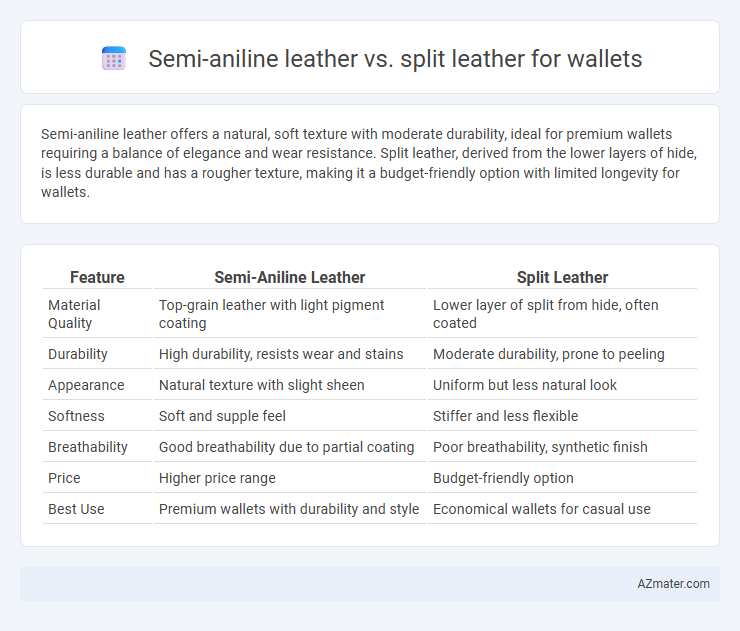Semi-aniline leather offers a natural, soft texture with moderate durability, ideal for premium wallets requiring a balance of elegance and wear resistance. Split leather, derived from the lower layers of hide, is less durable and has a rougher texture, making it a budget-friendly option with limited longevity for wallets.
Table of Comparison
| Feature | Semi-Aniline Leather | Split Leather |
|---|---|---|
| Material Quality | Top-grain leather with light pigment coating | Lower layer of split from hide, often coated |
| Durability | High durability, resists wear and stains | Moderate durability, prone to peeling |
| Appearance | Natural texture with slight sheen | Uniform but less natural look |
| Softness | Soft and supple feel | Stiffer and less flexible |
| Breathability | Good breathability due to partial coating | Poor breathability, synthetic finish |
| Price | Higher price range | Budget-friendly option |
| Best Use | Premium wallets with durability and style | Economical wallets for casual use |
Introduction to Semi-Aniline and Split Leather
Semi-aniline leather is crafted from high-quality hides dyed with soluble dyes, preserving the natural grain and texture while providing moderate protection with a light finish that enhances breathability and softness. Split leather, derived from the fibrous lower layers of the hide after top-grain separation, is often buffed and coated with synthetic pigments, resulting in a less natural look and lower durability compared to semi-aniline. Wallets made from semi-aniline leather offer superior aesthetics and aging qualities, whereas split leather wallets typically prioritize affordability and surface uniformity over natural feel and longevity.
What Is Semi-Aniline Leather?
Semi-aniline leather is a high-quality material treated with a light protective coating that preserves its natural grain and texture while offering enhanced durability and stain resistance, making it ideal for wallets. Unlike split leather, which is made from the lower layers of the hide and often coated with synthetic materials to mimic full grain appearance, semi-aniline leather retains more natural characteristics and a softer, more luxurious feel. This combination of natural beauty and practical resilience distinguishes semi-aniline leather wallets as premium products with superior aging qualities.
What Is Split Leather?
Split leather is derived from the lower layers of a hide after the top grain has been separated, making it less durable and less flexible than full grain or semi-aniline leather. It often has a polyurethane or other synthetic coating to mimic the appearance of higher-quality leather but lacks the natural texture and breathability. Wallets made from split leather tend to be more affordable but may wear out faster and show less character over time compared to semi-aniline leather.
Durability Comparison: Semi-Aniline vs Split Leather
Semi-aniline leather offers superior durability due to its minimal surface treatment that retains the natural grain, making it more resistant to wear and aging compared to split leather. Split leather, made from the lower layers of the hide, is generally less durable and prone to peeling and cracking over time because it lacks the protective top grain surface. For wallets requiring long-lasting resilience and a premium feel, semi-aniline leather is the preferred material.
Appearance and Texture Differences
Semi-aniline leather displays a smooth, natural grain with subtle color variations that enhance its rich, luxurious appearance, while split leather often has a synthetic or uniform finish due to the sanding process. The texture of semi-aniline leather is soft, supple, and breathable, maintaining the hide's original feel, whereas split leather tends to be stiffer and less responsive to touch. These distinctions make semi-aniline leather more desirable for wallets where aesthetics and tactile quality are prioritized.
Maintenance and Care Requirements
Semi-aniline leather wallets require moderate maintenance, including regular cleaning with a damp cloth and conditioning to preserve their natural oils and supple texture. Split leather wallets demand more intensive care due to their lower quality; they often need protective treatments to prevent cracking and wear caused by their fibrous surface. Proper care extends the lifespan of both types, but semi-aniline leather typically ages more gracefully with less frequent upkeep.
Price and Value Considerations
Semi-aniline leather wallets typically cost more due to higher-quality leather treated with light dye and a protective coating, offering enhanced durability and a natural appearance. Split leather wallets are more affordable, made from the lower layers of hides often bonded and coated, sacrificing some durability and aesthetic appeal. For buyers prioritizing longevity and premium look, semi-aniline leather provides better value despite the higher price, whereas split leather suits budget-conscious consumers seeking economical options.
Environmental Impact and Sustainability
Semi-aniline leather, processed with minimal surface coatings and fewer chemicals, offers a more environmentally sustainable choice compared to split leather, which involves additional mechanical splitting and heavy chemical treatments that increase pollution. The production of split leather generates more waste and requires significant energy consumption, whereas semi-aniline leather maintains a natural fiber structure, reducing chemical use and environmental degradation. Choosing semi-aniline leather wallets supports sustainability by promoting less intensive processing and a longer-lasting product lifecycle.
Best Use Cases for Each Leather Type
Semi-aniline leather offers a soft, natural texture with moderate protection, making it ideal for wallets used daily where both durability and a premium appearance matter. Split leather, derived from the fibrous part of the hide left after the top-grain is separated, provides a more affordable option with increased surface uniformity but less breathability, suited for budget-friendly wallets or designs emphasizing consistent texture. High-end wallets benefit from semi-aniline leather's rich patina and slight imperfection visibility, while split leather wallets excel in practicality and cost-effectiveness for mass-market use.
Which Leather Is Best for Your Wallet?
Semi-aniline leather offers a balance of durability and natural appearance, making it ideal for wallets that require both elegance and resilience. Split leather, derived from the lower layers of hide, is less durable and tends to wear out faster, making it less suitable for everyday wallet use. Choosing semi-aniline leather ensures a higher quality, longer-lasting wallet with a smooth finish that ages gracefully over time.

Infographic: Semi-aniline leather vs Split leather for Wallet
 azmater.com
azmater.com